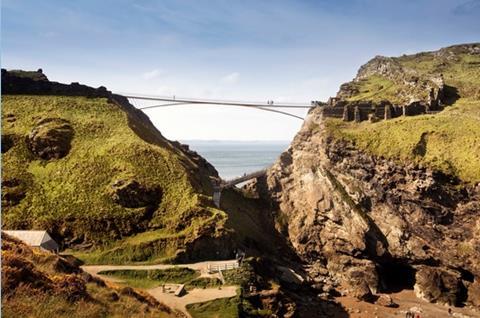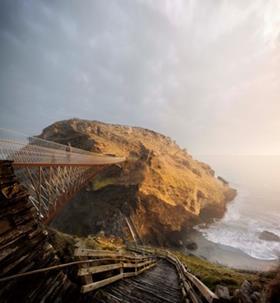William Matthews beat Niall McLaughlin, Marks Barfield and Wilkinson Eyre

Shard architect William Matthews has won the Tintagel Bridge competition.
Matthews teamed up with Belgian engineer and specialist bridge designer Ney & Partners for the £4m English Heritage project in Cornwall.
The pair beat 136 rival entries from nearly 30 countries in the two-stage design contest run by Malcolm Reading Consultants – including finalists Niall McLaughlin, Marks Barfield and Wilkinson Eyre.
They were chosen by a majority vote by the jury which was chaired by Graham Morrison of Allies & Morrison. The judges praised the proposal’s “elegant, delicate profile and structural ingenuity”.

The new bridge, 28m higher than the current crossing, will recreate the land-link that once existed between the mainland and headland.
It references the current void, caused by erosion, by using two cantilevers inspired by Tintagel’s original drawbridges. The design team said they envisaged a “poetic gap” between the two cantilevers.
Morrison said: “This is a strong and confident concept design with a thoughtful geometry that meets the demanding, multi-faceted brief.
“The team presented with admirable clarity – both at interview and in the written materials. In the end, the jury was persuaded as much by the technical assurance of Ney’s proposal, and its buildability, as its aesthetics and sensitivity to the exceptional setting.”
William Matthews, founder of William Matthews Associates, said they would use local slate for the decking and contrasting weathered and non-weathered steel to create finishes which they hoped would allow sunlight to play on the structure while also giving it an ephemeral quality.
He added: “Tintagel Castle attracts visitors for many reasons: the dramatic landscapes and geological formations, the Dark Ages remains, the ruined 12th-century castle and the legends of King Arthur and Tristan and Isolde. Together, they breathe an undeniable and powerful sense of life into the place. To be invited to contribute to that is a rare privilege and honour.”
Kate Mavor, chief executive of English Heritage, said: “The winning team’s concept is daring and very exciting. It is not the final design but instead a brilliant indication of the team’s talent and imagination. We will now work with them on a design that will both complement the spectacular landscape and unlock for the visitor the history of the site.”



























No comments yet